Hệ thống định vị và điều hướng trong nhà
Hệ thống định vị và điều hướng trong nhà đã và đang có nhu cầu ngày càng tăng với phát
triển của công nghệ điện thoại thông minh. Tuy nhiên cho tới thời điểm hiện tại hầu như chưa có một hệ
thống tiêu chuẩn nào đặt ra cho các hệ thống điều hướng trong nhà. Các hệ thống điều hướng trong nhà có
nhiều tác dụng, có thể kể đến như điều hướng hỗ trợ cho 7.3 triệu công dân khiếm thị ở Mỹ. Xét trên quy
mô toàn thế giới thì các hệ thống điều hướng kiểu này còn có tiềm năng lớn hơn rất nhiều lần. Do điểm
yếu của công nghệ GPS và tín hiệu không dây trong nhà nên vấn đề định vị và theo dõi trong nhà đã được
chứng minh là vấn đề khó khăn hơn so với điều kiện ngoài trời. Các phương pháp tiếp cận hiện nay đã và
đang sử dụng hướng tiếp cập bằng các kỹ thuật như mô hình xác thực vân tay kết hợp tần số vô tuyến để
định vị. Trong bài báo này chúng tôi đề xuất hệ thống BluNavi, một hệ thống điều hướng trong nhà hiệu
quả và có thể triển khai rộng rãi. Hệ thống bao gồm hai mô đun chính là: lấy dấu vân tay Wi-Fi và Bộ lọc
Kalman mở rộng dựa trên tín hiệu báo hiệu năng lượng thấp của bluetooth. Mỗi mô-đun được đánh giá
độ chính xác riêng của nó. Hệ thống lấy dấu vân tay đạt độ chính xác trung bình là 82,33% ± 3,07% với
độ tin cậy 95%. Mô hình tính toán góc chết đã thu được độ chính xác trung bình là 3,88m ± 0,37m với độ
tin cậy 95%. Mô hình lan truyền có độ chính xác 5,91m± 1,61m với độ tin cậy 95%. Bộ lọc Kalman mở
rộng với sử dụng cảm biến có độ chính xác 10,22m ± 0,91m với độ tin cậy 95 %.
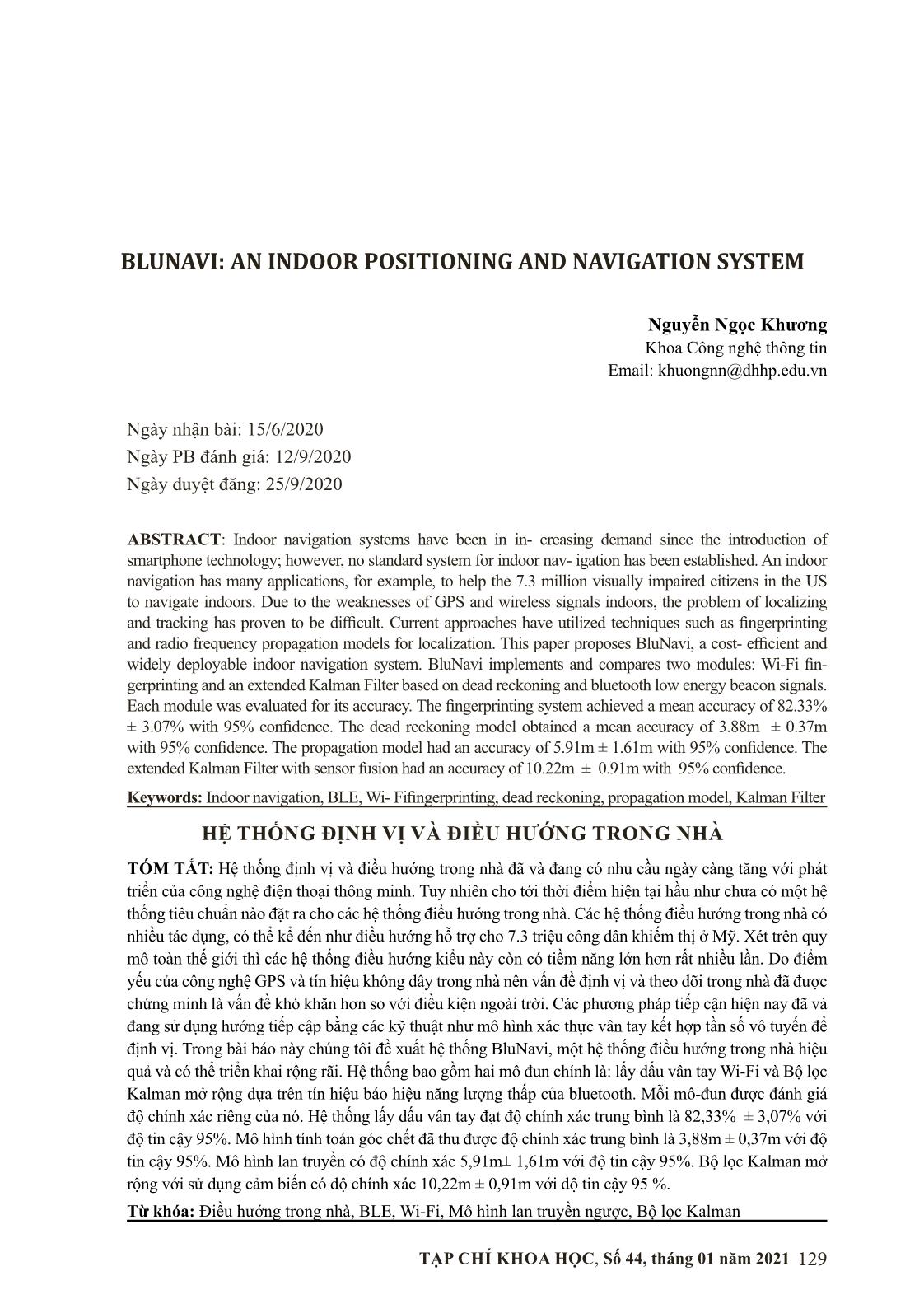
Trang 1
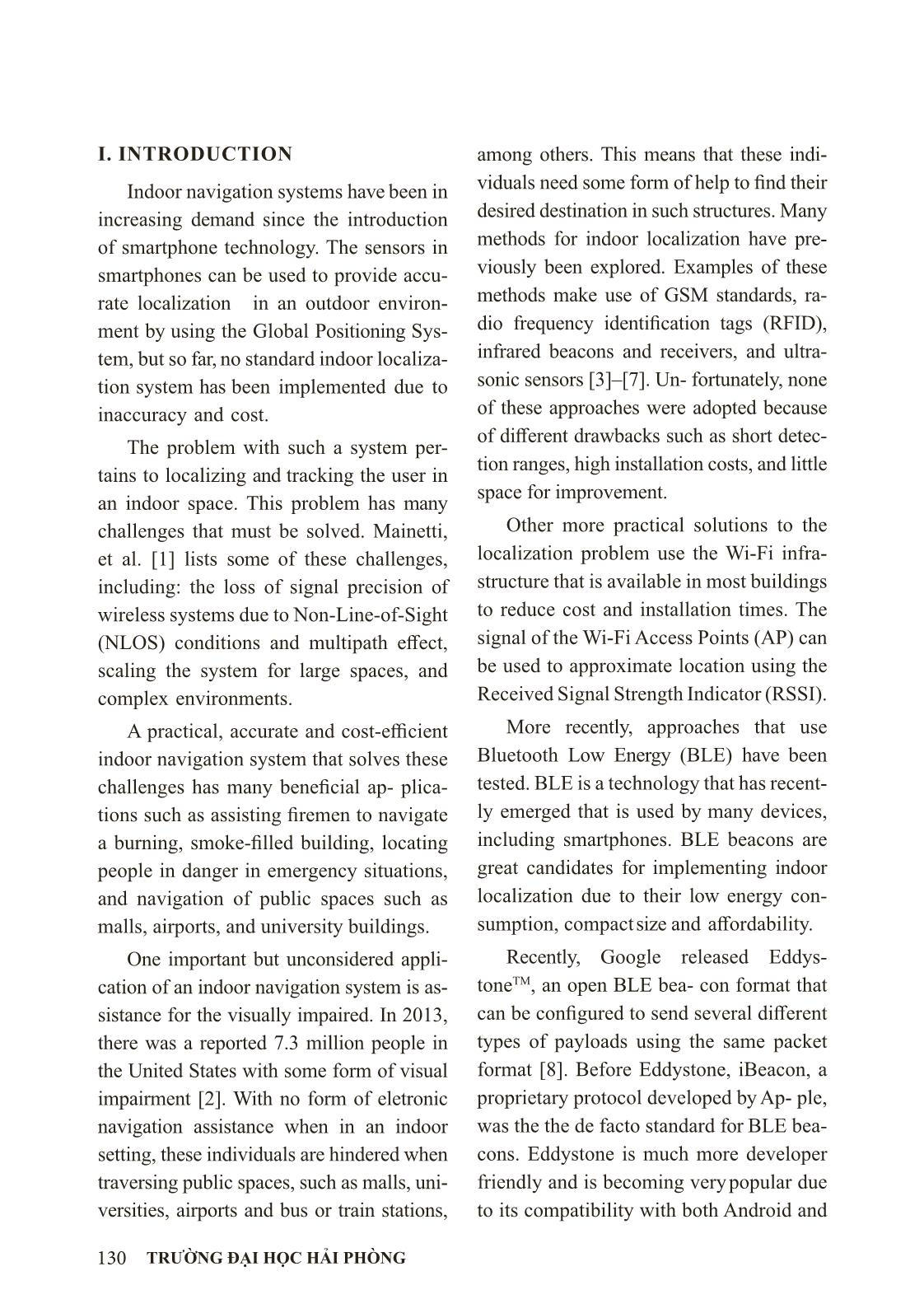
Trang 2
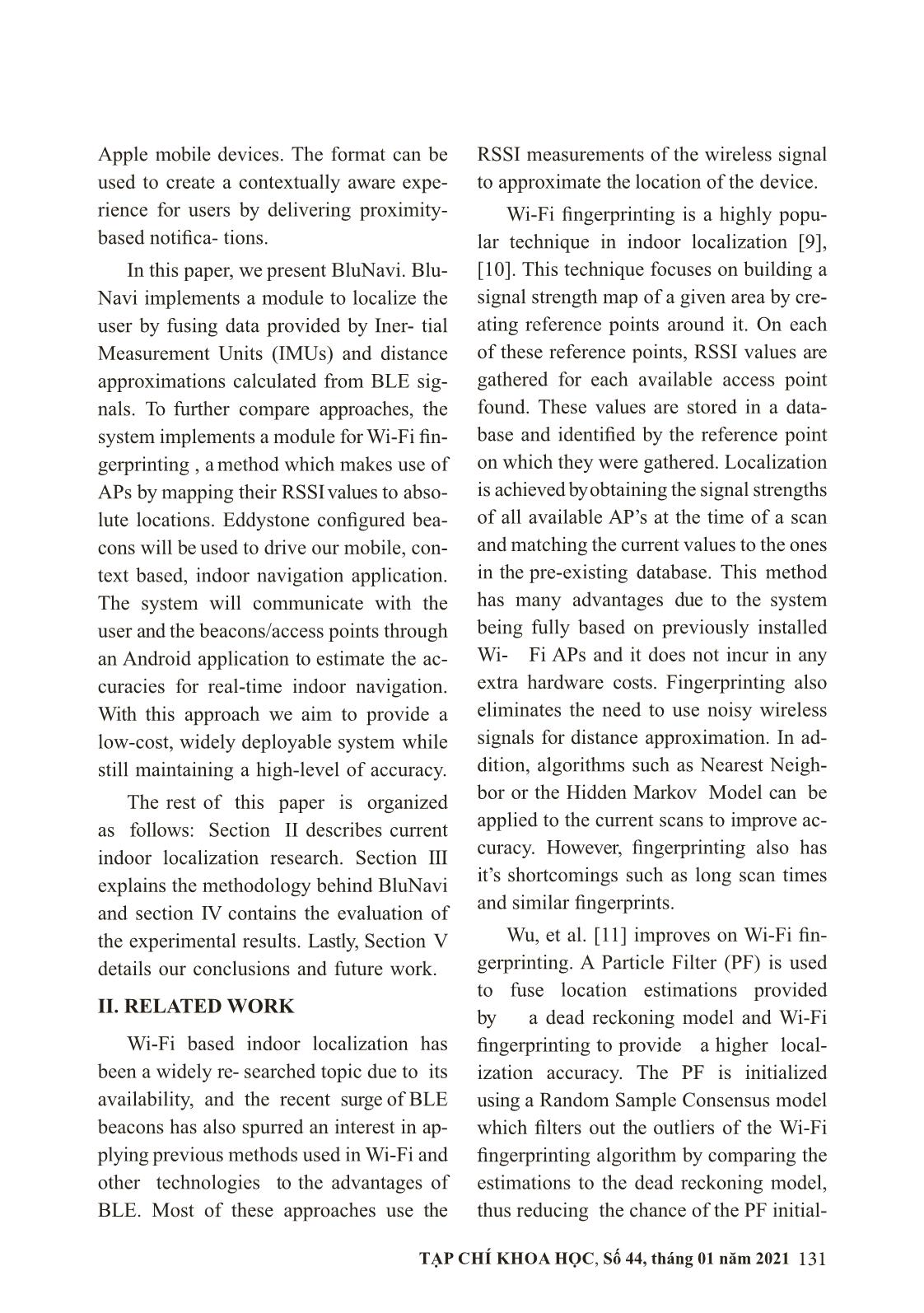
Trang 3
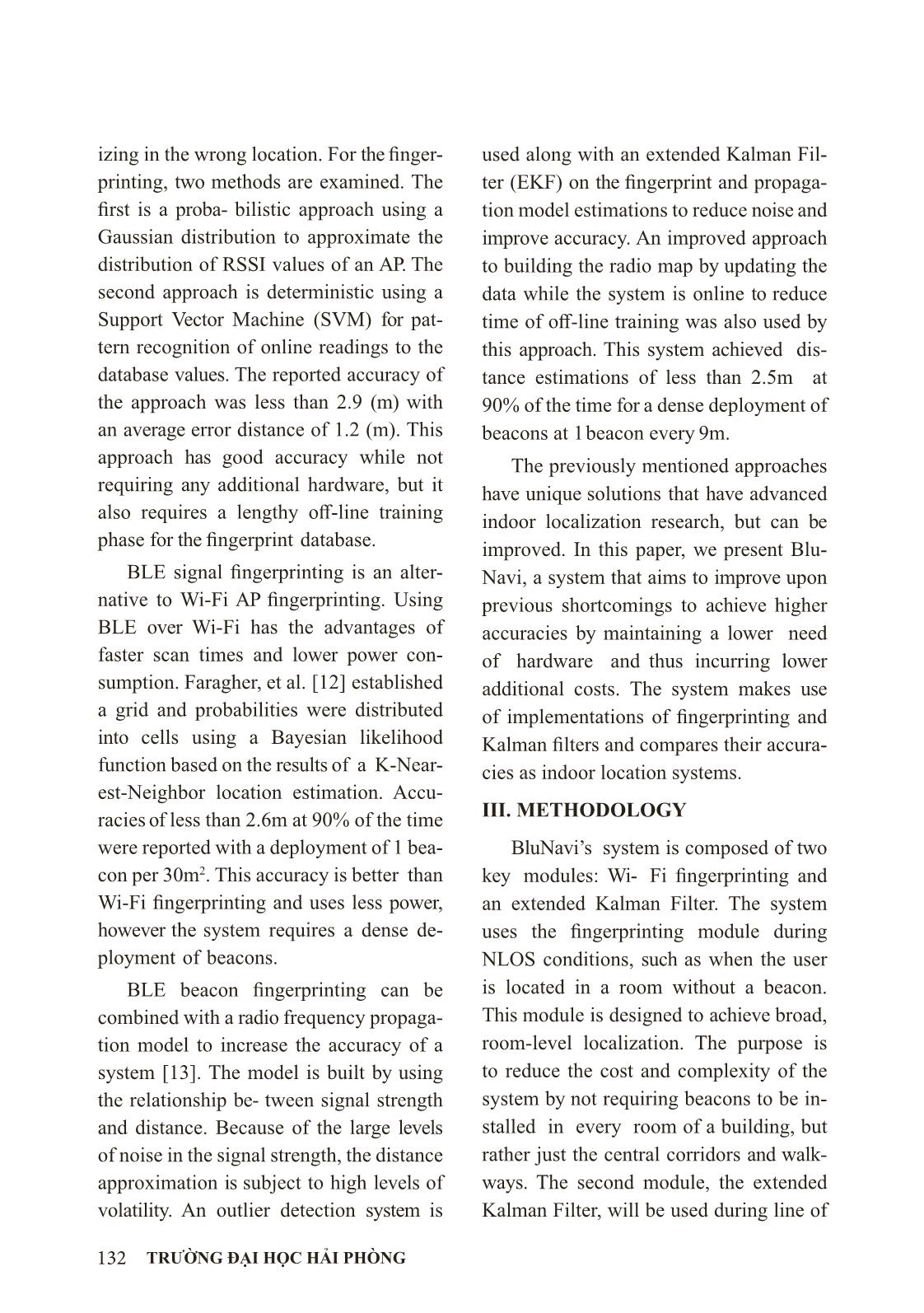
Trang 4
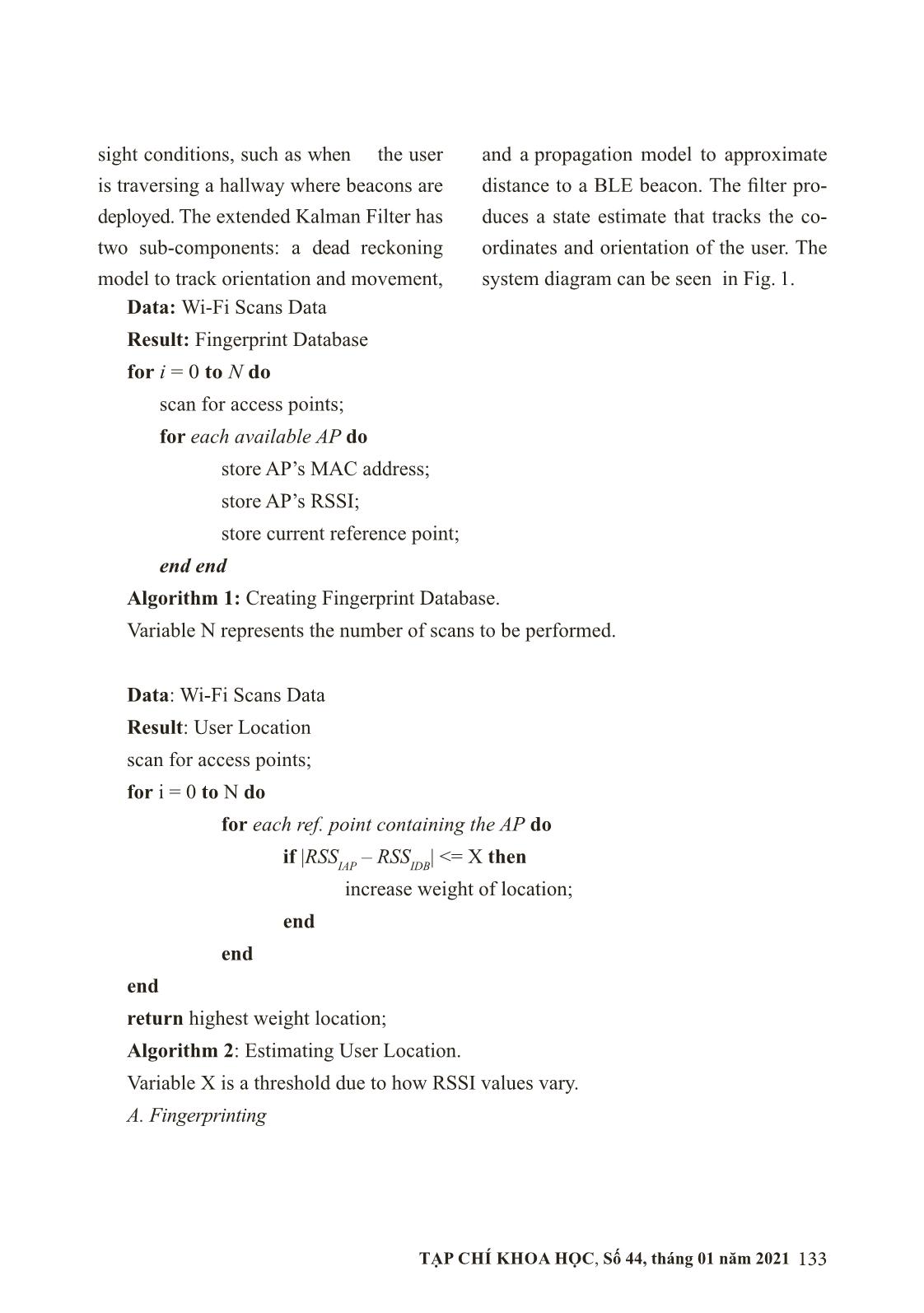
Trang 5
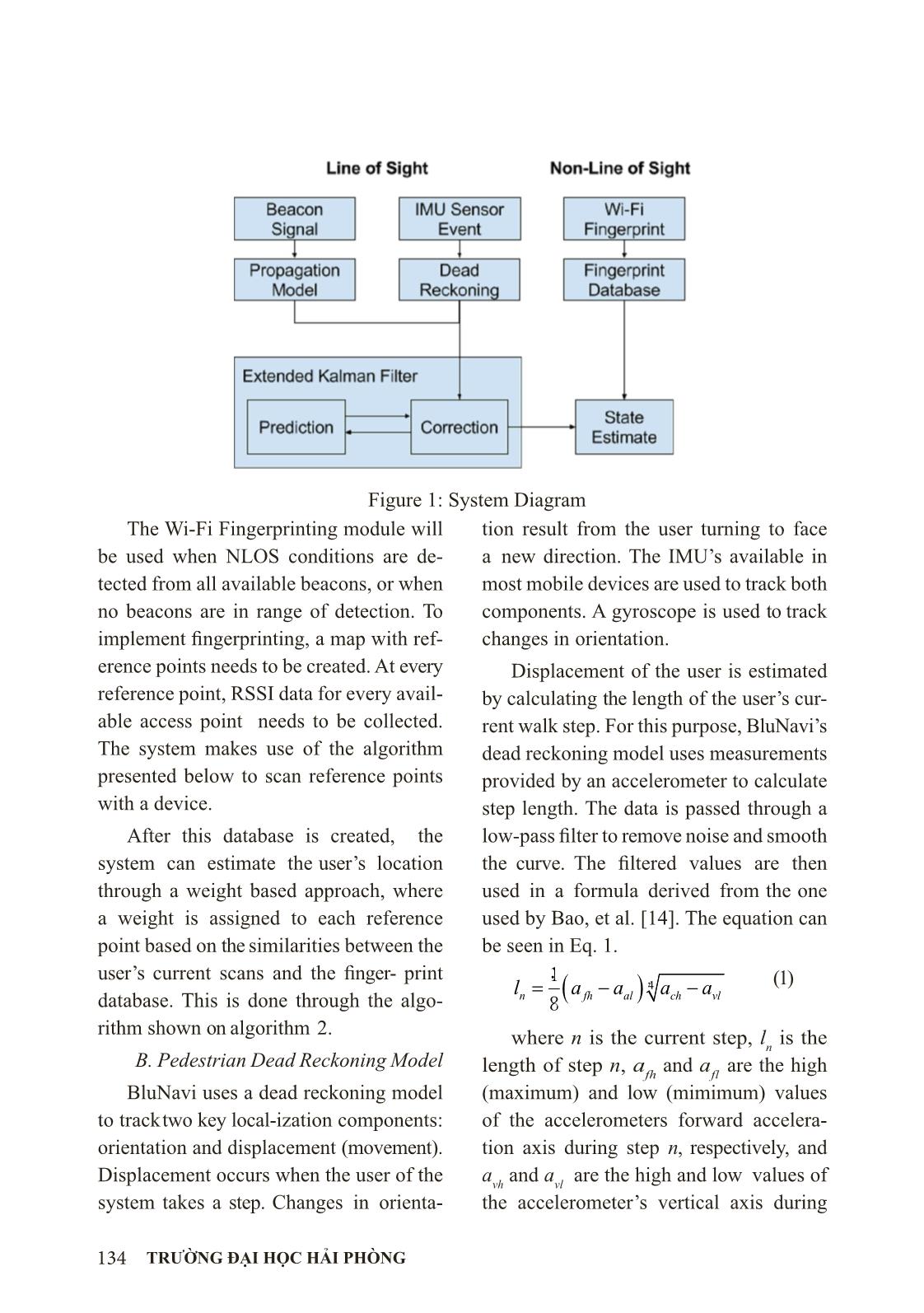
Trang 6
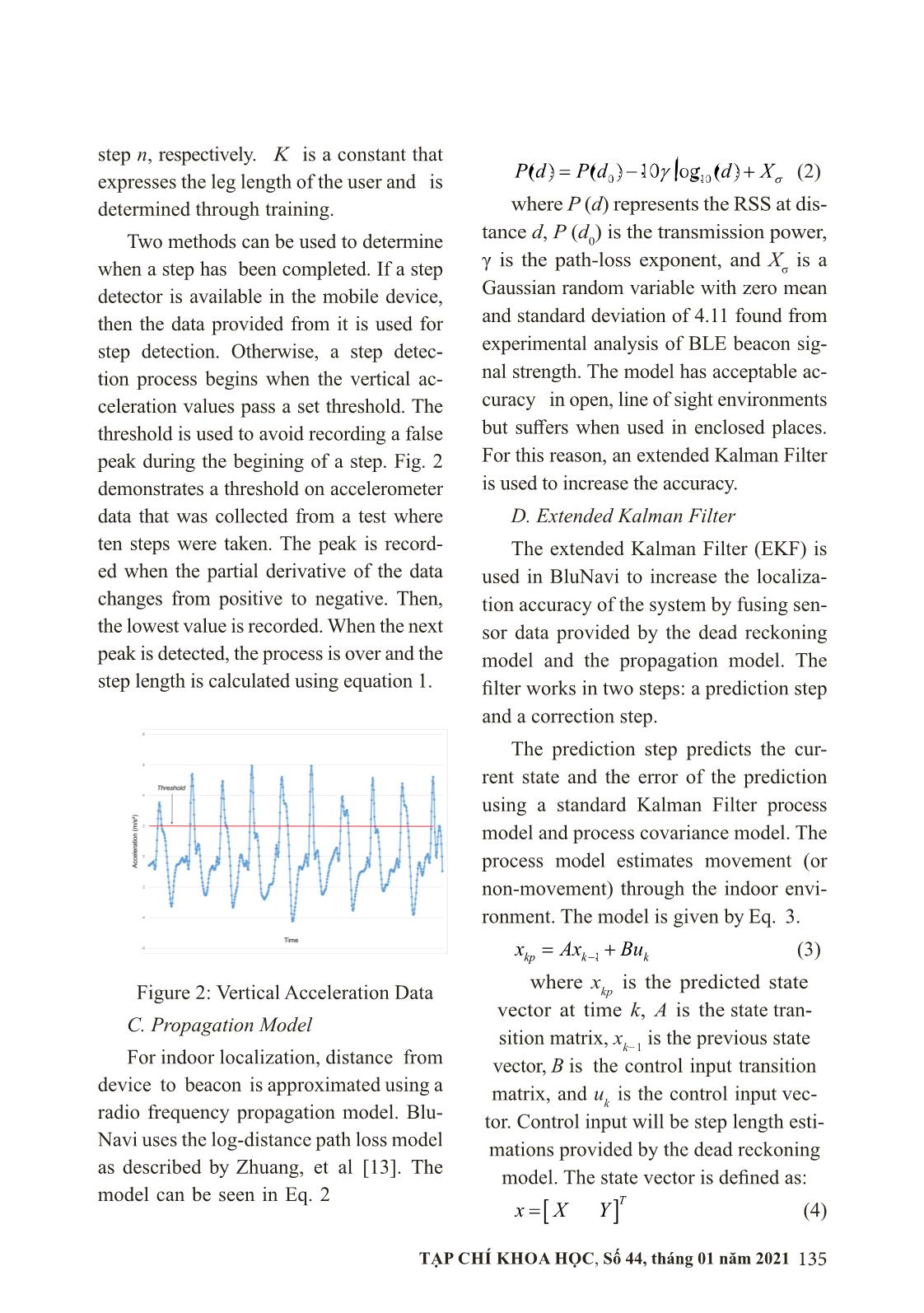
Trang 7
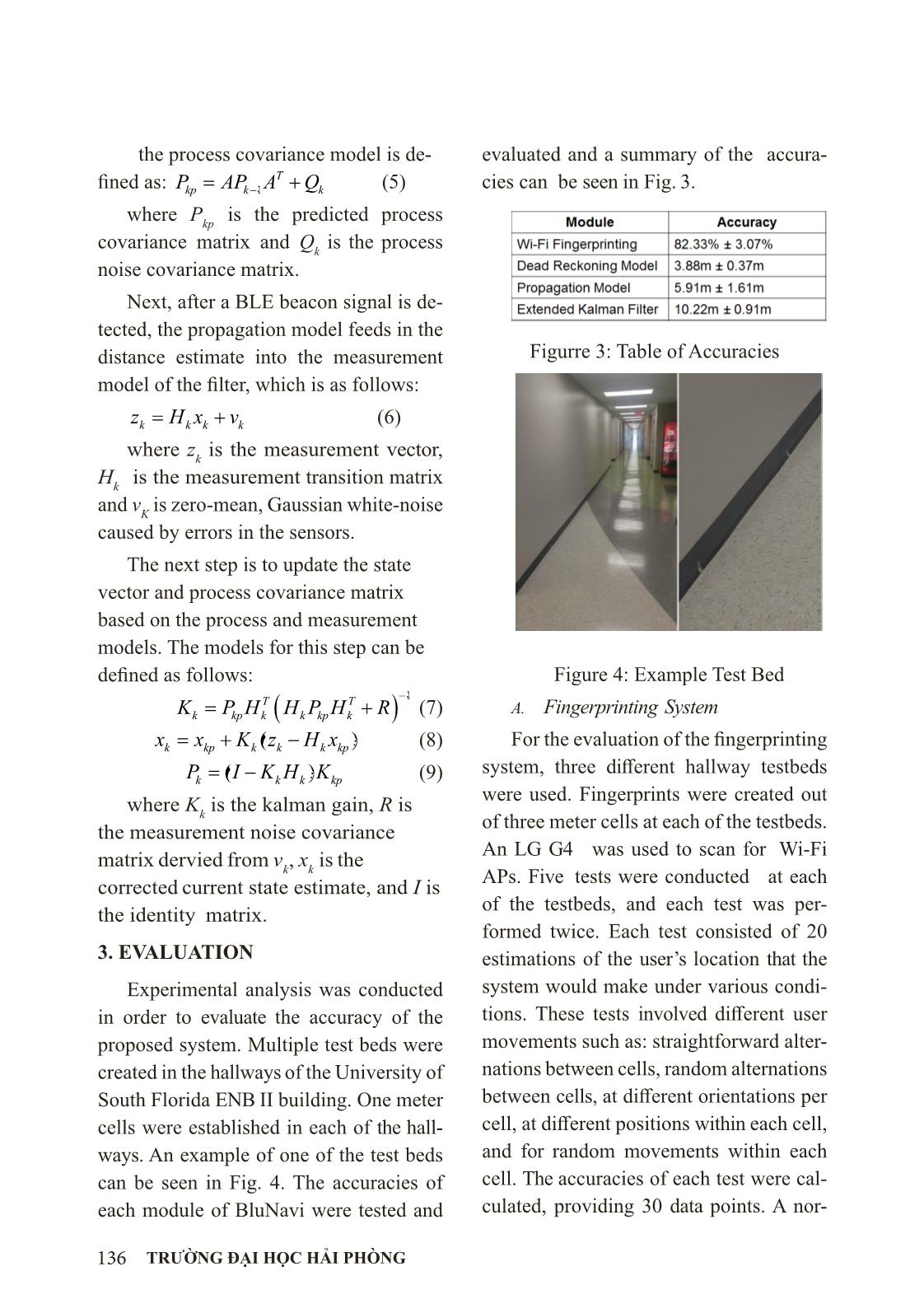
Trang 8
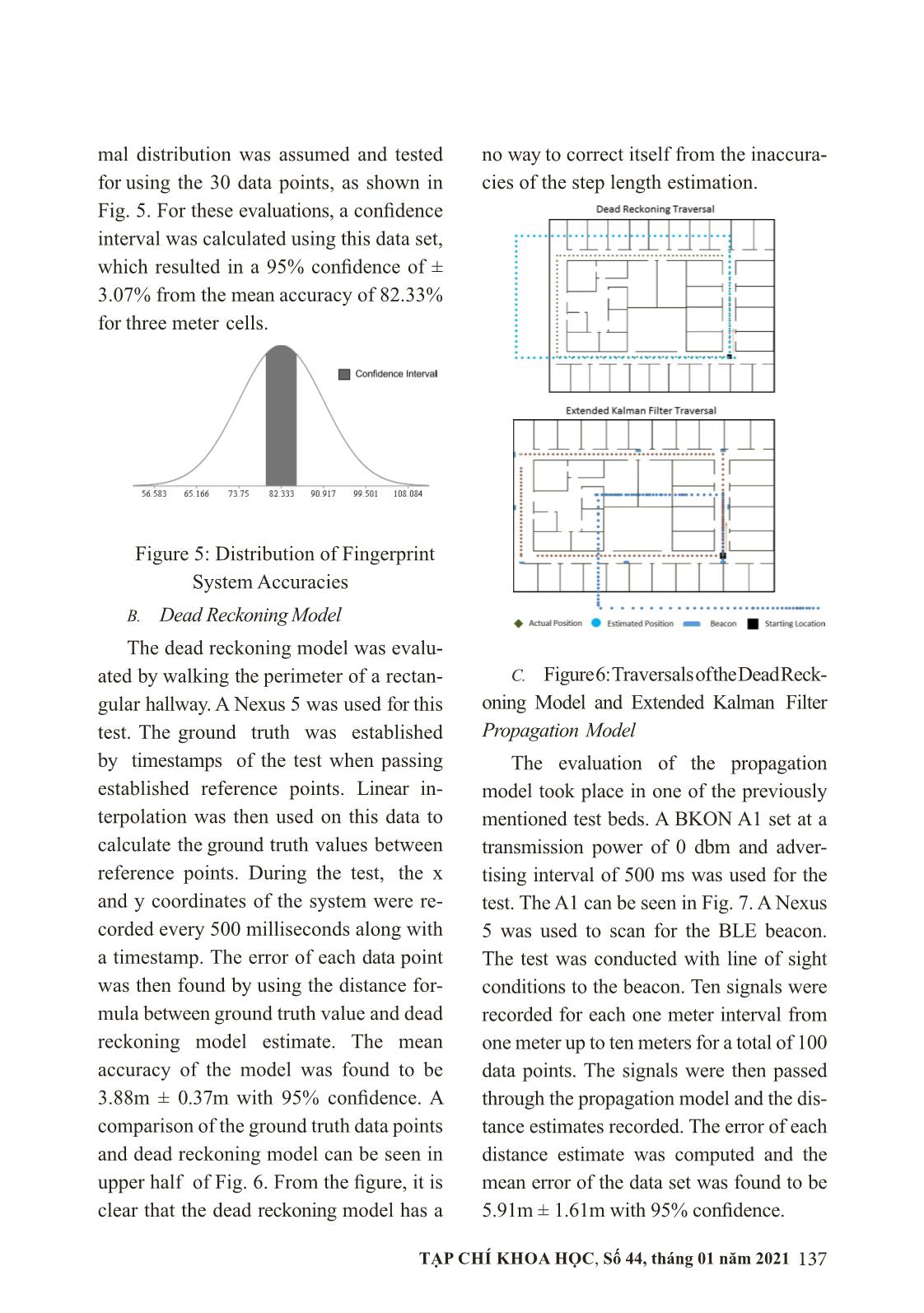
Trang 9
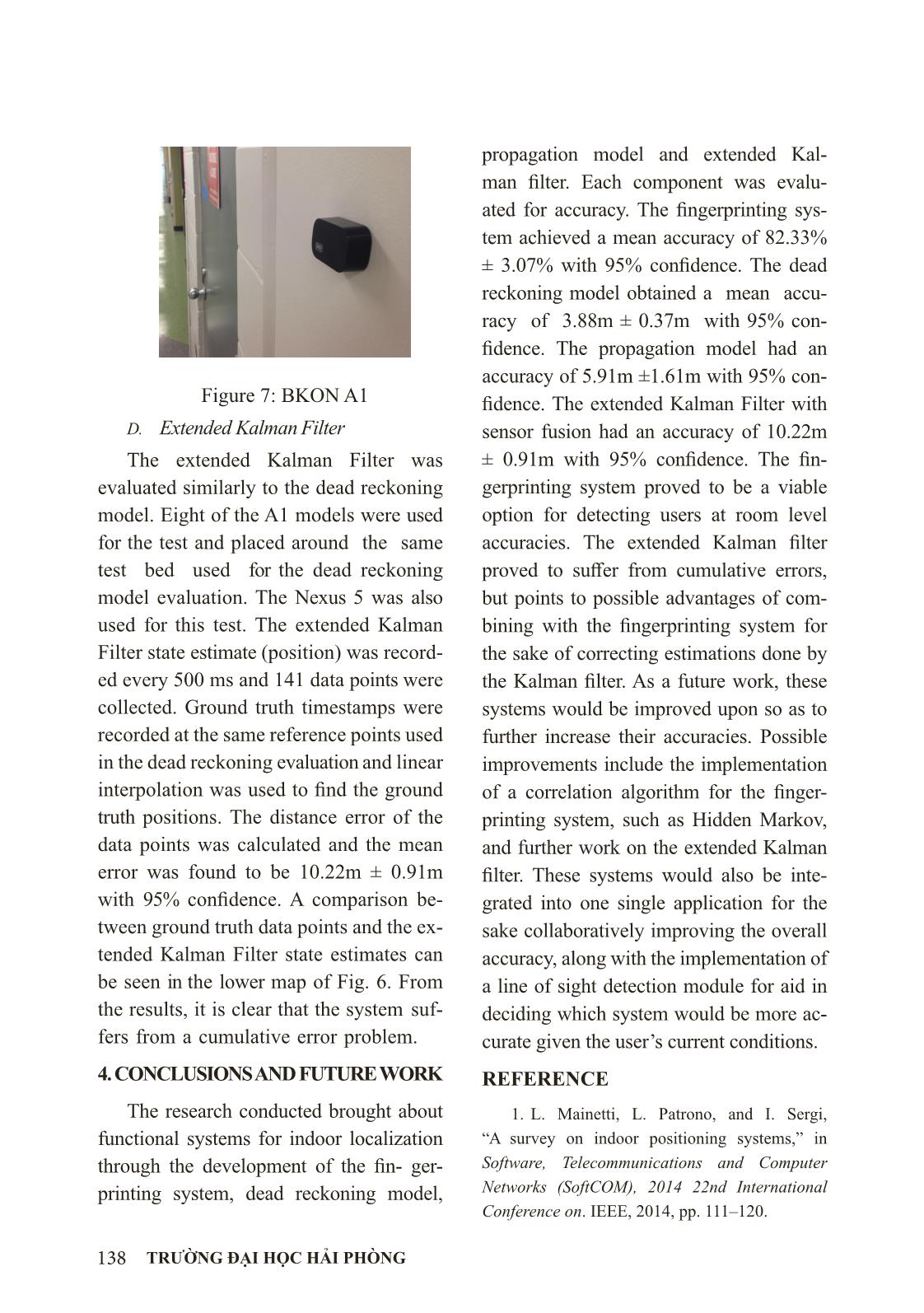
Trang 10
Tải về để xem bản đầy đủ
Tóm tắt nội dung tài liệu: Hệ thống định vị và điều hướng trong nhà

129TẠP CHÍ KHOA HỌC, Số 44, tháng 01 năm 2021 BLUNAVI: AN INDOOR POSITIONING AND NAVIGATION SYSTEM Nguyễn Ngọc Khương Khoa Công nghệ thông tin Email: khuongnn@dhhp.edu.vn Ngày nhận bài: 15/6/2020 Ngày PB đánh giá: 12/9/2020 Ngày duyệt đăng: 25/9/2020 ABSTRACT: Indoor navigation systems have been in in- creasing demand since the introduction of smartphone technology; however, no standard system for indoor nav- igation has been established. An indoor navigation has many applications, for example, to help the 7.3 million visually impaired citizens in the US to navigate indoors. Due to the weaknesses of GPS and wireless signals indoors, the problem of localizing and tracking has proven to be difficult. Current approaches have utilized techniques such as fingerprinting and radio frequency propagation models for localization. This paper proposes BluNavi, a cost- efficient and widely deployable indoor navigation system. BluNavi implements and compares two modules: Wi-Fi fin- gerprinting and an extended Kalman Filter based on dead reckoning and bluetooth low energy beacon signals. Each module was evaluated for its accuracy. The fingerprinting system achieved a mean accuracy of 82.33% ± 3.07% with 95% confidence. The dead reckoning model obtained a mean accuracy of 3.88m ± 0.37m with 95% confidence. The propagation model had an accuracy of 5.91m ± 1.61m with 95% confidence. The extended Kalman Filter with sensor fusion had an accuracy of 10.22m ± 0.91m with 95% confidence. Keywords: Indoor navigation, BLE, Wi- Fifingerprinting, dead reckoning, propagation model, Kalman Filter HỆ THỐNG ĐỊNH VỊ VÀ ĐIỀU HƯỚNG TRONG NHÀ TÓM TẮT: Hệ thống định vị và điều hướng trong nhà đã và đang có nhu cầu ngày càng tăng với phát triển của công nghệ điện thoại thông minh. Tuy nhiên cho tới thời điểm hiện tại hầu như chưa có một hệ thống tiêu chuẩn nào đặt ra cho các hệ thống điều hướng trong nhà. Các hệ thống điều hướng trong nhà có nhiều tác dụng, có thể kể đến như điều hướng hỗ trợ cho 7.3 triệu công dân khiếm thị ở Mỹ. Xét trên quy mô toàn thế giới thì các hệ thống điều hướng kiểu này còn có tiềm năng lớn hơn rất nhiều lần. Do điểm yếu của công nghệ GPS và tín hiệu không dây trong nhà nên vấn đề định vị và theo dõi trong nhà đã được chứng minh là vấn đề khó khăn hơn so với điều kiện ngoài trời. Các phương pháp tiếp cận hiện nay đã và đang sử dụng hướng tiếp cập bằng các kỹ thuật như mô hình xác thực vân tay kết hợp tần số vô tuyến để định vị. Trong bài báo này chúng tôi đề xuất hệ thống BluNavi, một hệ thống điều hướng trong nhà hiệu quả và có thể triển khai rộng rãi. Hệ thống bao gồm hai mô đun chính là: lấy dấu vân tay Wi-Fi và Bộ lọc Kalman mở rộng dựa trên tín hiệu báo hiệu năng lượng thấp của bluetooth. Mỗi mô-đun được đánh giá độ chính xác riêng của nó. Hệ thống lấy dấu vân tay đạt độ chính xác trung bình là 82,33% ± 3,07% với độ tin cậy 95%. Mô hình tính toán góc chết đã thu được độ chính xác trung bình là 3,88m ± 0,37m với độ tin cậy 95%. Mô hình lan truyền có độ chính xác 5,91m± 1,61m với độ tin cậy 95%. Bộ lọc Kalman mở rộng với sử dụng cảm biến có độ chính xác 10,22m ± 0,91m với độ tin cậy 95 %. Từ khóa: Điều hướng trong nhà, BLE, Wi-Fi, Mô hình lan truyền ngược, Bộ lọc Kalman ± 130 TRƯỜNG ĐẠI HỌC HẢI PHÒNG I. INTRODUCTION Indoor navigation systems have been in increasing demand since the introduction of smartphone technology. The sensors in smartphones can be used to provide accu- rate localization in an outdoor environ- ment by using the Global Positioning Sys- tem, but so far, no standard indoor localiza- tion system has been implemented due to inaccuracy and cost. The problem with such a system per- tains to localizing and tracking the user in an indoor space. This problem has many challenges that must be solved. Mainetti, et al. [1] lists some of these challenges, including: the loss of signal precision of wireless systems due to Non-Line-of-Sight (NLOS) conditions and multipath effect, scaling the system for large spaces, and complex environments. A practical, accurate and cost-efficient indoor navigation system that solves these challenges has many beneficial ap- plica- tions such as assisting firemen to navigate a burning, smoke-filled building, locating people in danger in emergency situations, and navigation of public spaces such as malls, airports, and university buildings. One important but unconsidered appli- cation of an indoor navigation system is as- sistance for the visually impaired. In 2013, there was a reported 7.3 million people in the United States with some form of visual impairment [2]. With no form of eletronic navigation assistance when in an indoor setting, these individuals are hindered when traversing public spaces, such as malls, uni- versities, airports and bus or train stations, among others. This means that these indi- viduals need some form of help to find t ... n scan for access points; for i = 0 to N do for each ref. point containing the AP do if |RSS IAP – RSS IDB | <= X then increase weight of location; end end end return highest weight location; Algorithm 2: Estimating User Location. Variable X is a threshold due to how RSSI values vary. A. Fingerprinting 134 TRƯỜNG ĐẠI HỌC HẢI PHÒNG Figure 1: System Diagram The Wi-Fi Fingerprinting module will be used when NLOS conditions are de- tected from all available beacons, or when no beacons are in range of detection. To implement fingerprinting, a map with ref- erence points needs to be created. At every reference point, RSSI data for every avail- able access point needs to be collected. The system makes use of the algorithm presented below to scan reference points with a device. After this database is created, the system can estimate the user’s location through a weight based approach, where a weight is assigned to each reference point based on the similarities between the user’s current scans and the finger- print database. This is done through the algo- rithm shown on algorithm 2. B. Pedestrian Dead Reckoning Model BluNavi uses a dead reckoning model to track two key local-ization components: orientation and displacement (movement). Displacement occurs when the user of the system takes a step. Changes in orienta- tion result from the user turning to face a new direction. The IMU’s available in most mobile devices are used to track both components. A gyroscope is used to track changes in orientation. Displacement of the user is estimated by calculating the length of the user’s cur- rent walk step. For this purpose, BluNavi’s dead reckoning model uses measurements provided by an accelerometer to calculate step length. The data is passed through a low-pass filter to remove noise and smooth the curve. The filtered values are then used in a formula derived from the one used by Bao, et al. [14]. The equation can be seen in Eq. 1. ( ) 418n fh al ch vll a a a a= − − (1) where n is the current step, l n is the length of step n, a fh and a fl are the high (maximum) and low (mimimum) values of the accelerometers forward accelera- tion axis during step n, respectively, and a vh and a vl are the high and low values of the accelerometer’s vertical axis during 135TẠP CHÍ KHOA HỌC, Số 44, tháng 01 năm 2021 step n, respectively. K is a constant that expresses the leg length of the user and is determined through training. Two methods can be used to determine when a step has been completed. If a step detector is available in the mobile device, then the data provided from it is used for step detection. Otherwise, a step detec- tion process begins when the vertical ac- celeration values pass a set threshold. The threshold is used to avoid recording a false peak during the begining of a step. Fig. 2 demonstrates a threshold on accelerometer data that was collected from a test where ten steps were taken. The peak is record- ed when the partial derivative of the data changes from positive to negative. Then, the lowest value is recorded. When the next peak is detected, the process is over and the step length is calculated using equation 1. Figure 2: Vertical Acceleration Data C. Propagation Model For indoor localization, distance from device to beacon is approximated using a radio frequency propagation model. Blu- Navi uses the log-distance path loss model as described by Zhuang, et al [13]. The model can be seen in Eq. 2 0 10( ) ( ) 10 log ( )P d P d d Xσγ= − + (2) where P (d) represents the RSS at dis- tance d, P (d 0 ) is the transmission power, γ is the path-loss exponent, and X σ is a Gaussian random variable with zero mean and standard deviation of 4.11 found from experimental analysis of BLE beacon sig- nal strength. The model has acceptable ac- curacy in open, line of sight environments but suffers when used in enclosed places. For this reason, an extended Kalman Filter is used to increase the accuracy. D. Extended Kalman Filter The extended Kalman Filter (EKF) is used in BluNavi to increase the localiza- tion accuracy of the system by fusing sen- sor data provided by the dead reckoning model and the propagation model. The filter works in two steps: a prediction step and a correction step. The prediction step predicts the cur- rent state and the error of the prediction using a standard Kalman Filter process model and process covariance model. The process model estimates movement (or non-movement) through the indoor envi- ronment. The model is given by Eq. 3. 1kp k kx Ax Bu−= + (3) where x kp is the predicted state vector at time k, A is the state tran- sition matrix, x k−1 is the previous state vector, B is the control input transition matrix, and u k is the control input vec- tor. Control input will be step length esti- mations provided by the dead reckoning model. The state vector is defined as: [ ]Tx X Y= (4) 136 TRƯỜNG ĐẠI HỌC HẢI PHÒNG the process covariance model is de- fined as: 1 T kp k kP AP A Q−= + (5) where P kp is the predicted process covariance matrix and Q k is the process noise covariance matrix. Next, after a BLE beacon signal is de- tected, the propagation model feeds in the distance estimate into the measurement model of the filter, which is as follows: k k k kz H x v= + (6) where z k is the measurement vector, H k is the measurement transition matrix and vK is zero-mean, Gaussian white-noise caused by errors in the sensors. The next step is to update the state vector and process covariance matrix based on the process and measurement models. The models for this step can be defined as follows: ( ) 1T Tk kp k k kp kK P H H P H R − = + (7) ( )k kp k k k kpx x K z H x= + − (8) ( )k k k kpP I K H K= − (9) where K k is the kalman gain, R is the measurement noise covariance matrix dervied from v k , x k is the corrected current state estimate, and I is the identity matrix. 3. EVALUATION Experimental analysis was conducted in order to evaluate the accuracy of the proposed system. Multiple test beds were created in the hallways of the University of South Florida ENB II building. One meter cells were established in each of the hall- ways. An example of one of the test beds can be seen in Fig. 4. The accuracies of each module of BluNavi were tested and evaluated and a summary of the accura- cies can be seen in Fig. 3. Figurre 3: Table of Accuracies Figure 4: Example Test Bed A. Fingerprinting System For the evaluation of the fingerprinting system, three diff erent hallway testbeds were used. Fingerprints were created out of three meter cells at each of the testbeds. An LG G4 was used to scan for Wi-Fi APs. Five tests were conducted at each of the testbeds, and each test was per- formed twice. Each test consisted of 20 estimations of the user’s location that the system would make under various condi- tions. These tests involved different user movements such as: straightforward alter- nations between cells, random alternations between cells, at different orientations per cell, at different positions within each cell, and for random movements within each cell. The accuracies of each test were cal- culated, providing 30 data points. A nor- 137TẠP CHÍ KHOA HỌC, Số 44, tháng 01 năm 2021 mal distribution was assumed and tested for using the 30 data points, as shown in Fig. 5. For these evaluations, a confidence interval was calculated using this data set, which resulted in a 95% confidence of ± 3.07% from the mean accuracy of 82.33% for three meter cells. Figure 5: Distribution of Fingerprint System Accuracies B. Dead Reckoning Model The dead reckoning model was evalu- ated by walking the perimeter of a rectan- gular hallway. A Nexus 5 was used for this test. The ground truth was established by timestamps of the test when passing established reference points. Linear in- terpolation was then used on this data to calculate the ground truth values between reference points. During the test, the x and y coordinates of the system were re- corded every 500 milliseconds along with a timestamp. The error of each data point was then found by using the distance for- mula between ground truth value and dead reckoning model estimate. The mean accuracy of the model was found to be 3.88m ± 0.37m with 95% confidence. A comparison of the ground truth data points and dead reckoning model can be seen in upper half of Fig. 6. From the figure, it is clear that the dead reckoning model has a no way to correct itself from the inaccura- cies of the step length estimation. C. Figure 6: Traversals of the Dead Reck- oning Model and Extended Kalman Filter Propagation Model The evaluation of the propagation model took place in one of the previously mentioned test beds. A BKON A1 set at a transmission power of 0 dbm and adver- tising interval of 500 ms was used for the test. The A1 can be seen in Fig. 7. A Nexus 5 was used to scan for the BLE beacon. The test was conducted with line of sight conditions to the beacon. Ten signals were recorded for each one meter interval from one meter up to ten meters for a total of 100 data points. The signals were then passed through the propagation model and the dis- tance estimates recorded. The error of each distance estimate was computed and the mean error of the data set was found to be 5.91m ± 1.61m with 95% confidence. 138 TRƯỜNG ĐẠI HỌC HẢI PHÒNG Figure 7: BKON A1 D. Extended Kalman Filter The extended Kalman Filter was evaluated similarly to the dead reckoning model. Eight of the A1 models were used for the test and placed around the same test bed used for the dead reckoning model evaluation. The Nexus 5 was also used for this test. The extended Kalman Filter state estimate (position) was record- ed every 500 ms and 141 data points were collected. Ground truth timestamps were recorded at the same reference points used in the dead reckoning evaluation and linear interpolation was used to find the ground truth positions. The distance error of the data points was calculated and the mean error was found to be 10.22m ± 0.91m with 95% confidence. A comparison be- tween ground truth data points and the ex- tended Kalman Filter state estimates can be seen in the lower map of Fig. 6. From the results, it is clear that the system suf- fers from a cumulative error problem. 4. CONCLUSIONS AND FUTURE WORK The research conducted brought about functional systems for indoor localization through the development of the fin- ger- printing system, dead reckoning model, propagation model and extended Kal- man filter. Each component was evalu- ated for accuracy. The fingerprinting sys- tem achieved a mean accuracy of 82.33% ± 3.07% with 95% confidence. The dead reckoning model obtained a mean accu- racy of 3.88m ± 0.37m with 95% con- fidence. The propagation model had an accuracy of 5.91m ±1.61m with 95% con- fidence. The extended Kalman Filter with sensor fusion had an accuracy of 10.22m ± 0.91m with 95% confidence. The fin- gerprinting system proved to be a viable option for detecting users at room level accuracies. The extended Kalman filter proved to suffer from cumulative errors, but points to possible advantages of com- bining with the fingerprinting system for the sake of correcting estimations done by the Kalman filter. As a future work, these systems would be improved upon so as to further increase their accuracies. Possible improvements include the implementation of a correlation algorithm for the finger- printing system, such as Hidden Markov, and further work on the extended Kalman filter. These systems would also be inte- grated into one single application for the sake collaboratively improving the overall accuracy, along with the implementation of a line of sight detection module for aid in deciding which system would be more ac- curate given the user’s current conditions. REFERENCE 1. L. Mainetti, L. Patrono, and I. Sergi, “A survey on indoor positioning systems,” in Software, Telecommunications and Computer Networks (SoftCOM), 2014 22nd International Conference on. IEEE, 2014, pp. 111–120. 139TẠP CHÍ KHOA HỌC, Số 44, tháng 01 năm 2021 2. “National Federation of the Blind blindness statistics”, https://nfb.org/blindness-statistics, accessed: 2016-06-20. 3. V. Otsason, A. Varshavsky, A. LaMarca, and E. De Lara, “Accurate gsm indoor localization,” in International conference on ubiquitous computing. Springer, 2005, pp. 141–158. 4. N. Li and B. Becerik-Gerber, “Performance- based evaluation of rfid- based indoor location sensing solutions for the built environment,” Advanced Engineering Informatics, vol. 25, no. 3, pp. 535–546, 2011. 5. J. Liu, “Survey of wireless based indoor localization technologies,” Dept. of Science & Engineering, Washington University, 2014. 6. A. Ward, A. Jones, and A. Hopper, “A new location technique for the active office,” IEEE Personal Communications, vol. 4, no. 5, pp. 42– 47, 1997. 7. C. Medina, J. C. Segura, and A. De la Torre, “Ultrasound indoor positioning system based on a low-power wireless sensor network providing sub- centimeter accuracy,” Sensors, vol. 13, no. 3, pp. 3501– 3526, 2013. 8. “Google beacons eddystone format,” https://developers.google.com/beacons/eddystone, accessed: 2016- 05-24. 9. S. Chan and G. Sohn, “Indoor localization using wi-fi based finger- printing and trilateration techiques for lbs applications,” International Archives of the Photogrammetry, Remote Sensing and Spatial Informa- tion Sciences, vol. 38, p. 4, 2012. 10. E. Navarro, B. Peuker, and M. Quan, “Wi-fi localization using rssi fin- gerprinting,” Bachelor’s thesis, California Polytechnic State University, 2010. 11. Z. Wu, E. Jedari, R. Muscedere, and R. Rashidzadeh, “Improved particle filter based on wlan rssi fingerprinting and smart sensors for indoor localization,” Computer Communications, vol. 83, pp. 64–71, 2016. 12. R. Faragher and R. Harle, “Location fingerprinting with bluetooth low energy beacons,” IEEE Journal on Selected Areas in Communications, vol. 33, no. 11, pp. 2418–2428, 2015. 13. Y. Zhuang, J. Yang, Y. Li, L. Qi, and N. El- Sheimy, “Smartphone-based indoor localization with bluetooth low energy beacons,” Sensors, vol. 16, no. 5, p. 596, 2016. 14. H. Bao and W.-C. Wong, “An indoor dead- reckoning algorithm with map matching,” in 2013 9th International Wireless Communications and Mobile Computing Conference (IWCMC). IEEE, 2013, pp. 1534–1539.
File đính kèm:
 he_thong_dinh_vi_va_dieu_huong_trong_nha.pdf
he_thong_dinh_vi_va_dieu_huong_trong_nha.pdf

